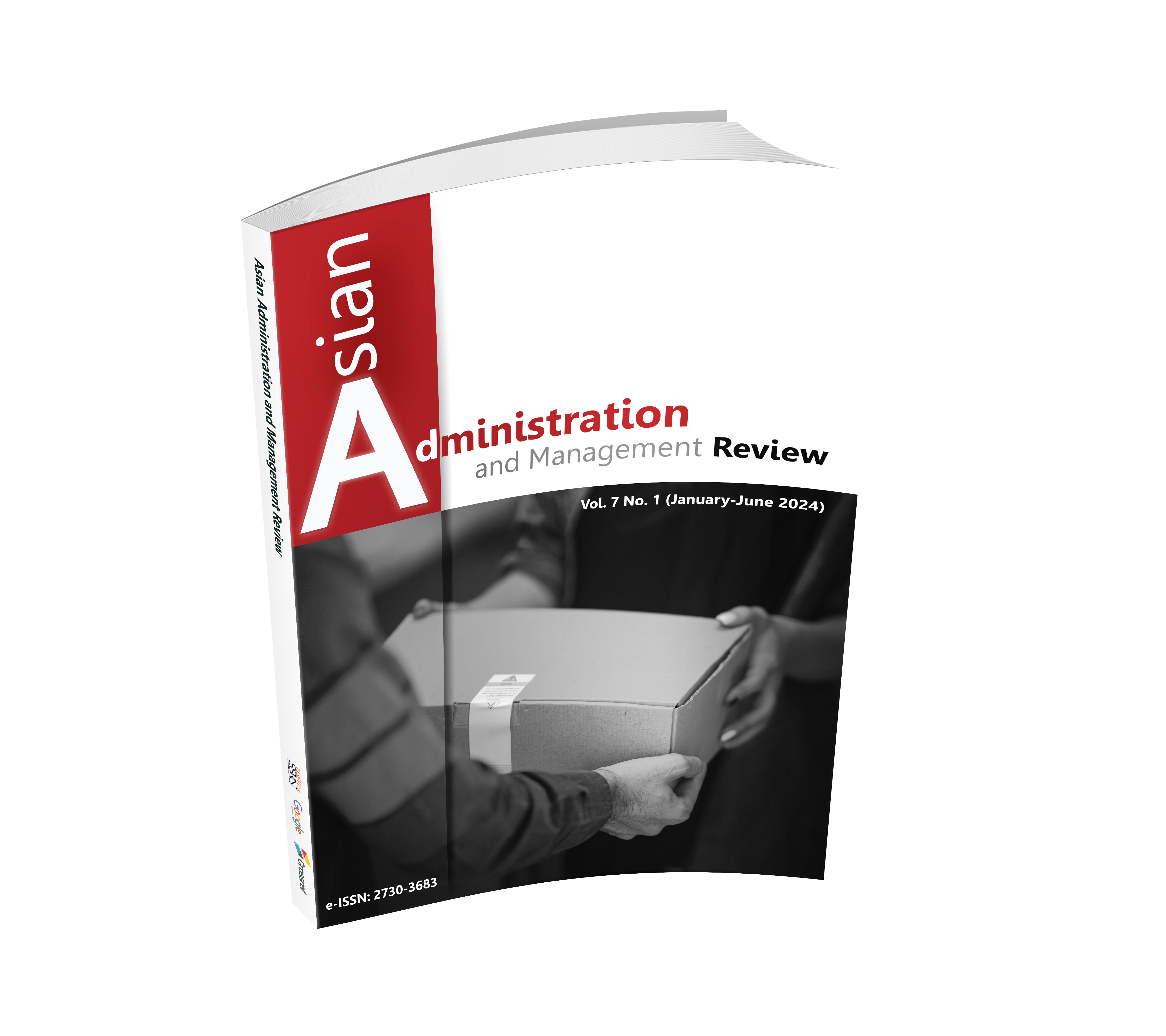THE IMPACT OF STRATEGIC AGILITY ON OPERATIONAL RESPONSIVENESS AND FIRM PERFORMANCE OF IMPORT, EXPORT, AND LOGISTICS ENTERPRISES
DOI:
https://doi.org/10.14456/aamr.2024.14Keywords:
Strategic Agility, Operational Responsiveness, Firm Performance, Import and Export, Logistics EnterprisesAbstract
The purpose of this research was to study the impact of strategic agility comprising technology capability, collaborative innovation, organizational learning, and internal alignment on operational responsiveness and firm performance of import, export and logistics enterprises. The research methodology was quantitative research with survey method by using questionnaires for data collection. The respondents were 400 importers, exporters, and logistics service providers located in the Bangkok Metropolitan Region. Samples were selected using non-probability sampling with a purposive sampling technique. Descriptive statistics used for data analysis included frequency, percentage, mean, and standard deviation. Due to hypothesis testing, inferential statistics used were Pearson’s Product Moment Correlation Coefficient and Partial Least Squares-Structural Equation Modeling. The findings indicated that strategic agility had the strongest positive effect on operational responsiveness and firm performance, and operational responsiveness mediated the effect of strategic agility on firm performance at a significance level of 0.001. Besides, operational responsiveness had positive and significant effect on firm performance at a significance level of 0.001.
Downloads
References
Adamik, A., Nowicki, M., & Szymańska, K. (2018). Openness to co-creation as a method of reducing the complexity of the environment and dynamizing companies’ competitive advantages. Management & Marketing. Challenges for the Knowledge Society, 13(2), 880-896.
Ando, M., & Iriyama, A. (2009). International production networks and export/import responsiveness to exchange rates: The case of Japanese manufacturing firms (Working Paper ERIA-DP-2009-09). Jakarta: Economic Research Institute for ASEAN and East Asia.
Bagozzi, R., & Yi, Y. (2012). Specification, evaluation, and interpretation of structural equation models. Journal of the Academy of Marketing Science, 40(1), 8-34.
Bahrami, M., Kiani, M., Montazeralfaraj, R., Zadeh, H., & Zadeh, M. (2016). The mediating role of organizational learning in the relationship of organizational intelligence and organizational agility. Osong Public Health and Research Perspectives, 7(3), 190-196.
Bariyyah, S., & Malau, M. (2023). Effect of liquidity, asset structure, managerial ownership and growth rate on company performance. Journal of Economics, Finance and Accounting Studies, 5(3), 87-95.
Barney, J. (1991). Firm resources and sustained competitive advantage. Journal of Management, 17(1), 99-120.
Brannen, M., & Doz, Y. (2012). Corporate languages and strategic agility: Trapped in your jargon or lost in translation?. California Management Review, 54(3), 77-97.
Braunscheidel, M., & Suresh, N. (2009). The organizational antecedents of a firm’s supply chain agility for risk mitigation and response. Journal of Operations Management, 27(2), 119-140.
Cao, Q., & Dowlatshahi, S. (2005). The impact of alignment between virtual enterprise and information technology on business performance in an agile manufacturing environment. Journal of Operations Management, 23(5), 531-550.
Choi, T., & Krause, D. (2006). The supply base and its complexity: Implications for transaction costs, risks, responsiveness, and innovation. Journal of Operations Management, 24(5), 637-652.
Cochran, W. (1953). Sampling techniques. New York: John Wiley & Sons. Inc.
Daft, R. (1978). A dual-core model of organizational innovation. Academy of Management Journal, 21(2), 193-210.
De Araújo Lima, P., Crema, M., & Verbano, C. (2020). Risk management in SMEs: A systematic literature review and future directions. European Management Journal, 38(1), 78-94.
Doz, Y., & Kosonen, M. (2008). The dynamics of strategic agility: Nokia’s rollercoaster experience. California Management Review, 50(3), 95-118.
Dwivedi, R., Prasad, K., Mandal, N., Singh, S., Vardhan, M., & Pamucar, D. (2021). Performance evaluation of an insurance company using an integrated Balanced Scorecard (BSC) and Best-Worst Method (BWM). Decision Making: Applications in Management and Engineering, 4(1), 33-50.
Fornell, C., & Larcker, D. (1981). Structural equation models with unobservable variables and measurement error: Algebra and statistics. Journal of Marketing Research, 18(3), 382-388.
Gerwin, D. (1993). Manufacturing flexibility: A strategic perspective. Management Science, 39(4), 395-410.
Herciu, M., & Șerban, R. (2018). Measuring firm performance: Testing a proposed model. Studies in Business and Economics, 13(2), 103-114.
Hoyt, J., Huq, F., & Kreiser, P. (2007). Measuring organizational responsiveness: the development of a validated survey instrument. Management Decision, 45(10), 1573-1594.
Inman, R., Sale, R., Green Jr., K., & Whitten, D. (2011). Agile manufacturing: Relation to JIT, operational performance and firm performance. Journal of Operations Management, 29(4), 343-355.
Khan, K., & Mahmood, Z. (2023). Impact of corporate governance on firm performance: A case of Pakistan stock exchange. Liberal Arts and Social Sciences International Journal, 7(1), 24-38.
Kumkale, İ. (2016). Organization’s tool for creating competitive advantage: Strategic agility. Balkan and Near Eastern Journal of Social Sciences, 2(3), 118-124.
Kuo, K., Lu, W., & Dinh, T. (2020). Firm performance and ownership structure: Dynamic network data envelopment analysis approach. Managerial and Decision Economics, 41(4), 608-623.
LeBreton, J., Wu, J., & Bing, M. (2009). The truth(s) on testing for mediation in the social and organizational sciences. In C. Lance, & R. Vandenberg. (eds.). Statistical and methodological myths and urban legends: Doctrine, verity and fable in the organizational and social sciences (pp. 107-141). London: Routledge.
Lee, H. (2004). The triple-a supply chain. Harvard Business Review, 82(10), 102-112.
Lee, J., Swink, M., & Pandejpong, T. (2010). The roles of worker expertise, information sharing quality, and psychological safety in manufacturing process innovation: An intellectual capital perspective. Production and Operations Management, 20(4), 556-570.
Li, X., Chung, C., Goldsby, T., & Clyde, W. (2008). A unified model of supply chain agility: The work-design perspective. The International Journal of Logistics Management, 19(3), 408-435.
Liew, C., Prakash, J., & Ong, K. (2022). Integration of financial performance measure with overall equipment effectiveness for assessing operational performance: A structured literature review. International Journal of Productivity and Quality Management, 37(1), 119-142.
Lu, Y., & Ramamurthy, K. (2011). Understanding the link between information technology capability and organizational agility: An empirical examination. MIS Quarterly, 35(4), 931-954.
Mbah, A., & Okwo, I. (2022). Responsiveness of operational performance to liquid asset management of industrial goods firms in Nigeria. European Journal of Accounting, Auditing and Finance Research, 10(12), 14-28.
McLean, J., Clark, C., McKee, A., Legue, S., Cocking, J., Lamarche, A., & DiDiodato, G. (2022). Pandemic responsiveness in an acute care setting: A community hospital’s utilization of operational resources during COVID-19. Journal of Multidisciplinary Healthcare, 15, 1309-1321.
McWilliams, A., & Smart, D. (1993). Efficiency v. structure-conduct-performance: Implications for strategy research and practice. Journal of Management, 19(1), 63-78.
Mohanarajan, A. (2016). “Business” as an art form. [Unpublished master thesis]. Ontario College of Art and Design University.
Monyei, E., Okeke, P., & Nwosu, K. (2021). Strategic agility: A prospect for sustainable performance of micro-businesses in South-Eastern Nigeria. Journal of Sustainable Tourism and Entrepreneurship, 2(3), 187-198.
Nenavani, J., & Jain, R. (2022). Examining the impact of strategic supplier partnership, customer relationship and supply chain responsiveness on operational performance: The moderating effect of demand uncertainty. Journal of Business & Industrial Marketing, 37(5), 995-1011.
Nenavani, J., & Jain, R. (2023). Uncertainty, responsiveness and operational performance in supply chain: a conceptual study using contingency theory approach. International Journal of Services and Operations Management, 45(2), 207-231.
Novatiani, R. (2021). Analysis of financial performance affecting corporate value. Turkish Journal of Computer and Mathematics Education, 12(8), 1006-1009.
Nugroho, M. (2015). Impact of government support and competitor pressure on the readiness of SMEs in Indonesia in adopting the information technology. Procedia Computer Science, 72, 102-111.
Panda, S., & Rath, S. (2021). How information technology capability influences organizational agility: Empirical evidences from Indian banking industry. Journal of Indian Business Research, 13(4), 564-585.
Panigrahi, A. (2019). Analysis of financial performance: A study of selected pharmaceutical companies. Global Management Horizon, Annual Referred Journal of Global Institute of Management, 8, 47-56.
Păunescu, C., Argatu, R., & Lungu, M. (2018). Implementation of ISO 22000 in Romanian companies: Motivations, difficulties and key benefits. Amfiteatru Economic, 20(47), 30-45.
Pett, T., & Wolff, J. (2007). SME performance: A case for internal consistency. Journal of Small Business Strategy, 18(1), 1-16.
Roberts, N., & Grover, V. (2012). Investigating firm’s customer agility and firm performance: The importance of aligning sense and respond capabilities. Journal of Business Research, 65(5), 579-585.
Robinson, A., & Stern, S. (1998). Corporate creativity: How innovation and improvement actually happen. California: Berrett-Koehler Publishers.
Saha, N., Gregar, A., & Sáha, P. (2017). Organizational agility and HRM strategy: Do they really enhance firms’ competitiveness?. International Journal of Organizational Leadership, 6(3), 323-334.
Sahi, G., Gupta, M., Cheng, T., & Lonial, S. (2019). Relating entrepreneurial orientation with operational responsiveness: Roles of competitive intensity and technological turbulence. International Journal of Operations & Production Management, 39(5), 739-766.
Santosa, W., & Triwulandari, S. (2023). Examining the impact of strategic supplier partnerships, customer relationship, postponement, and supply chain responsiveness on operational performance: The moderating effect of demand uncertainty. Business and Entrepreneurial Review, 23(1), 19-32.
Savalei, V., & Bentler, P. (2005). A statistically justified pairwise ML method for incomplete nonnormal data: A comparison with direct ML and pairwise ADF. Structural Equation Modeling, 12(2), 183-214.
Scherer, F., & Ross, D. (1990). Industrial market structure and economic performance. 3rd ed. Massachusetts: Houghton Mifflin.
Sheel, A., & Nath, V. (2019). Effect of blockchain technology adoption on supply chain adaptability, agility, alignment and performance. Management Research Review, 42(12), 1353-1374.
Shin, H., Lee, J., Kim, D., & Rhim, H. (2015). Strategic agility of Korean small and medium enterprises and its influence on operational and firm performance. International Journal of Production Economics, 168, 181-196.
Sohail, H., Tariq, S., & Tariq, A. (2023). Evaluating antecedents of online customer retention. Pakistan Journal of Humanities and Social Sciences, 11(2), 1337-1351.
Sud-on, P. (2014). Exploring the relationship between manufacturing practices, agile capabilities and organisational performance: A case of the Thai automotive parts industry. Doctor of Philosophy Thesis, RMIT University.
Swafford, P., Ghosh, S., & Murthy, N. (2006). A framework for assessing value chain agility. International Journal of Operations & Production Management, 26(2), 118-140.
Tallon, P., & Pinsonneault, A. (2011). Competing perspectives on the link between strategic information technology alignment and organizational agility: Insights from a mediation model. MIS quarterly, 35(2), 463-486.
Thomas, N., Singh, S., & Gangwar, M. (2023). Customer retention using loyalty cards program. International Journal of Business Innovation and Research, 30(2), 200-217.
Vickery, S., Droge, C., Setia, P., & Sambamurthy, V. (2010). Supply chain information technologies and organisational initiatives: Complementary versus independent effects on agility and firm performance. International Journal of Production Research, 48(23), 7025-7042.
Wang, K., Lee, C., Zhang, J., & Wei, Y. (2018). Operational performance management of the power industry: A distinguishing analysis between effectiveness and efficiency. Annals of Operations Research, 268, 513-537.
Whitten, G., Green, K., & Zelbst, P. (2012). Triple‐A supply chain performance. International Journal of Operations & Production Management, 32(1), 28-48.
Yuan, K., & Bentler, P. (2000). Three likelihood-based methods for mean and covariance structure analysis with nonnormal missing data. Sociological Methodology, 30(1), 165-200.
Zaheer, A., & Zaheer, S. (1997). Catching the wave: Alertness, responsiveness, and market influence in global electronic networks. Management Science, 43(11), 1493-1509.

Downloads
Published
How to Cite
Issue
Section
License
Copyright (c) 2024 Authors

This work is licensed under a Creative Commons Attribution-NonCommercial-NoDerivatives 4.0 International License.











.png)


